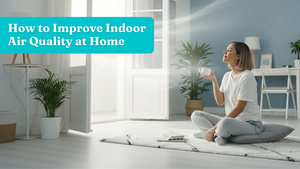Let's be real, when did you last consider the air within your own home? You can't see it, but it has a significant impact on how you feel day to day. Allergies and headaches, dry skin and fatigue are just some of the ways that poor indoor air quality can quietly disrupt your comfort and your well-being.
If you've ever wondered how to make indoor air quality at home better, you're in the right place. Whether you're a parent with children, a pet owner, or someone who just wants to breathe cleaner air, let's discuss some simple ways to freshen up your indoor space—without complicating things and breaking the bank.
Why Indoor Air Quality Matters
Here's the thing: indoor air can be five times more contaminated than air outside. And we spend a great deal of time indoors—particularly on scorching summer or freezing winter days. Dust, pet dander, mold spores, cooking odors, and even chemicals from cleaning products can all contribute.
Enhancing indoor air quality isn't so much about comfort—it's about safeguarding your health, particularly if you have asthma, allergies, or respiratory issues.
1. Let Fresh Air In

It may sound basic, but opening a window, even for a few minutes a day—can work miracles. Natural air flow assists in pushing out stale air and allowing fresh oxygen to enter. If the weather (or pollen level) permits, make it a daily routine.
2. Use an Air Purifier the Right Way

Air purifiers are an excellent tool, provided you're using them appropriately. Here are some tips for using home air purifiers to keep in mind:
- Put it strategically: Before placing your air purifier in a room, position it in areas where you spend the most time—such as the living room or bedroom.
- Clean or change filters regularly so that they keep working for you.
- Operate it regularly, particularly if you reside in an area with high traffic or during allergy season.
Pro tip: Find a purifier that removes both big particles (such as dust and pet hair) and tiny ones (such as pollen and bacteria).
3. Minimize Indoor Air Pollution from Everyday Sources

Certain pollutants creep into your house without your knowledge. Here's how to minimize indoor air pollution naturally:
- Drop synthetic air fresheners: They smell good but tend to contain VOCs (volatile organic compounds). Use essential oils or baking soda instead.
- Replace chemical cleaners: Vinegar, lemon, and baking soda can clean a lot of mess without emitting strong fumes.
- Don't smoke inside and reduce the use of incense or candles.
4. Maintain Humidity to Prevent Mold

Excess moisture in the air? That's an invitation for mold and mildew. Not enough? Say hello to dry skin and scratchy sinuses.
A small dehumidifier manages humidity, particularly in basements, bathrooms, or wet climates. Humidity between 30–50% is optimal for healthy indoor air.
5. Don't Forget to Clean What You Can't See

Air vents, ceiling fans, behind furniture—these areas can accumulate dust and allergens that find their way to circulate in your home.
Here's a quick rundown:
- Clean vents and fans every month
- Vacuum carpets and rugs frequently (use a HEPA filter if available)
- Clean curtains and upholstered furniture every few weeks
6. Go Natural with Air-Purifying Bags

Need an easy, low-fuss way to revitalize the air? Bamboo charcoal bags are the answer. They naturally pull in moisture, odors, and airborne toxins.
You can put them:
- In closets to minimize stinky odors
- In gym bags or shoes
- Near litter boxes or trash cans
- By windows to battle humidity
They're also reusable—just leave them out in the sun once a month to "recharge" them.
Your Indoor Air Health Matters
Improving indoor air quality doesn’t require a major renovation or pricey solutions. With a few smart habits and tools like running an air purifier, using a dehumidifier, or tossing a charcoal bag in the corner—you can create a cleaner, healthier space for yourself and your family.
Final Thoughts: Breathe Easy, One Step at a Time
Now that you understand how to enhance indoor air quality, begin small. Select one or two of the suggestions above and incorporate them into your routine. Every minor adjustment makes a difference—and your lungs will appreciate it.
Looking for easy tools to help out? Clevast’s small dehumidifier is perfect for tackling excess moisture in bedrooms or bathrooms. Pair it with moisture absorber boxes or packets for tight spaces like closets, and don’t forget to toss in a few bamboo charcoal air purifying bags to naturally trap odors and pollutants around your home.
You’ve got options—now it’s just about making your space feel (and smell) a little fresher every day!

